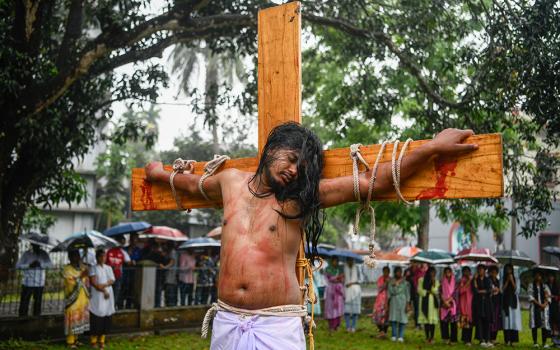ROME -- December 8 is the Feast of the Immaculate Conception, a national holiday in Italy. For those Americans who may wonder what Cardinal Bernard Law is up to these days, the Feast of the Immaculate Conception also provides one piece of the answer.
Since the time of John XXIII, the Feast Day’s traditional highlight is a papal outing to the Piazza di Spagna, where the pontiff prays before a column of the Immaculate Conception inaugurated by Pius IX a century and a half ago, three years after the formal proclamation of the dogma in 1854. Flowers will also be deposited at the column, following a custom begun under Pius XII.
Benedict XVI will make the traditional visit this afternoon at 4:00 pm Rome time.
Law, of course, is the former Archbishop of Boston who resigned in December 2002 amid the sexual abuse crisis that erupted in the United States. In May 2004 he was appointed the Archpriest of the Basilica of St. Mary Major – a move viewed in Rome as a “soft landing” for a prelate whose career had stalled in disgrace, though one that generated (and still generates) controversy in the States, where the job is instead sometimes popularly understood as a kind of papal honor.
In Rome, being the Archpriest of St. Mary Major, in itself, is generally not perceived as terribly prestigious.
St. Mary Major is one of the four “papal basilicas” in Rome, the others being St. John Lateran, St. Paul Outside the Walls, and St. Peter’s itself. The Archpriests of St. John Lateran and St. Peter’s are considered the more important administrative posts, since the archpriest of St. John Lateran is generally also the Vicar of Rome and an important player in the Italian bishops’ conference, while the archpriest of St. Peter’s is also the President of the Fabric of St. Peter and thus has a role in internal Vatican governance.
Until 2005 St. Paul Outside the Walls didn’t have a cardinal-archpriest, but now both it and St. Mary Major are considered by church insiders to be logical destinations for cardinals, usually Italians, nearing the end of their careers, after their major labors for the church are over. The current Archpriest of St. Paul Outside the Walls, for example, is 76-year-old Cardinal Francesco Monterisi, who served for more than a decade as the number two official in the Vatican’s Congregation for Bishops.
That category of “cardinals nearing the end” would be the one into which the 79-year-old Law also falls, at least in terms of Roman perceptions. Next November, when he reaches the age of 80, Law automatically will lose his right to vote in the next papal election, and will also no longer be a member of policy-making bodies in the Vatican such as the Congregation for Bishops.
However, Law will be able to continue his duties at St. Mary Major, a basilica built in honor of the Blessed Virgin Mary and thus a central focus for Marian devotion. That profile makes today a big day at Law’s basilica.
This morning, Law led a Pontifical Mass in honor of the Feast of the Immaculate Conception. Though at one stage hobbled by back problems after his arrival in Rome six years ago, Law processed down the central aisle of the basilica this morning and addressed the large congregation in a strong voice.
He welcomed a group of Spaniards, noting that the King of Spain by papal custom is considered the “first canon” of the Basilica of St. Mary Major. (The Spanish Ambassador to the Holy See represented the King at this morning’s Mass.) Law observed that a statue of King Philip IV of Spain adorns the basilica’s entrance, in part because Philip pushed the popes of the seventeenth century to proclaim the dogma of the Immaculate Conception, a full two centuries before it actually happened.
In his homily, Law quoted Cardinal John Henry Newman, the 19th century convert from Anglicanism recently beatified by Benedict XVI, to the effect that Mary is the virgo predicanda, meaning “the virgin who is to be proclaimed.” Newman, Law said, insisted that Catholics are obliged to preach about Mary, and especially her “highest, rarest, choicest prerogative,” which was being born without sin.
(Sometimes confused with belief in the virginal birth of Christ, the dogma of the Immaculate Conception actually refers to belief that Mary was conceived without the stain of original sin. Though long a feature of popular Marian devotion, the Immaculate Conception generated theological controversy through the centuries, especially among critics who felt it undercut the universal human need for salvation through Christ.)
It’s an “unfortunate reality,” Law said, that sometimes faith in Christ is opposed to devotion to Mary. In truth, he insisted, Mary is “the mother of all those reborn into new life in Christ.”
Echoing Newman’s famous insight about the development of dogma, Law indirectly acknowledged that faith in Mary’s Immaculate Conception wasn’t fully formed at the beginning, but rather developed “in the course of centuries” as the church “came to understand ever more deeply that Mary was redeemed from the moment of her conception.”
Throughout the Mass this morning, Law seemed strikingly at home as a Roman pastor.
He told several hundred Romans gathered in St. Mary Major that in this city and throughout Italy, where there are so many shrines and churches and other memorials to Mary, “it’s easy to take our Catholic faith for granted.”
Speaking in fluent Italian, Law said that today’s feast offers the “great grace” of providing an opportunity “to reflect on the mystery of the Immaculate Conception.”
One obvious difference between the United States and Rome is that while any public appearance by Law in America would likely be a media event, there was no noticeable press presence in St. Mary Major this morning.
For most Romans, in other words, Law is just another cardinal in winter.
[John L. Allen, Jr. is NCR's senior correspondent.]



